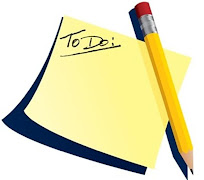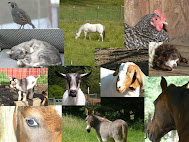Here's a question for you...do you purchase everyday, discount art supplies for your children or seek out quality items? Crayons for example, do you give any thought to them? Grab whichever is cheapest off the rack? That would have been me until I read an interesting article years back about a family that gave their child real, working art materials to use once they realized the amount of satisfaction and creativity the child expressed when they were able to produce projects with quality art supplies. Since then I've tried to obtain 'real' supplies for my children...within reason of course...and have been surprised at how they love the feel of crayons that go down smoothly, colored pencils that do not produce thin, scratchy lines, and creamy paints that cover well and just plain feel good underneath your brush.
Here's a few of our current favorites:
Stockmar Crayons.jpg)
We had relegated crayons to the maybe-again-sometime-down-the-time project area because my youngest wasn't interested in what she could produce with them. All until our neighbor purchased a small set of these crayons for her last Christmas. Until you actually use a quality crayon, you have no idea that there is even a difference. They produce thick color on the page, blend well with the other color already put down, and have vibrant colors. She decided not only to draw with them, but produce full pages of color as they were so inviting to use. I noticed on Stockmar's site they have some product information sheets that I plan to check out with additional creative uses of their crayons.
Prismacolor Colored Pencils.jpg)
I have been a fan of these since my earliest days homeschooling. I believe Timberdoodle Co. Homeschool Curriculum exposed me to them. They too put down a smooth, creamy color that can be blended and used to completely fill areas. No thin, pale color here. They are a bit spendy, but taken care of properly, our box has lasted a decade or more. It's now time to purchase another, and now that Michael's has put them as a 40% off item, I'm out to get another set. They too have some tips and tricks for their colored pencils, although they are geared towards the older student or parent who could then relay the information to your child in a manner useful to them.
BioColor Paints.jpg)
There are no better tempura paints around. Once again, the key seems to be color that goes down thick enough to actually produce vibrant colors. The paint is so creamy and smooth underneath your brush, you just want to keep on painting. I don't recall having a staining problem with clothes on younger painters as we've been out of that real messy stage for awhile, but precaution is probably advised. I believe these BioColor paints are produced and sold only by Discount School Supply but are well worth the cost of paying shipping and handling versus purchasing something local. The BioColor paints are so popular they have a link on their site for watching videos and downloading activities that can extend the normal use of their paints.
So the next time you head out to pick up craft supplies for your children, think about what you're buying. If it doesn't feel good in their hands or look good on the paper, irregardless of their abilities, you won't be giving them a chance to keep going with their project and expand their creativity. Do you have a favorite art supply that has made a difference in your children's love for art? If so, please share. We just might need to adopt another new favorite.
Tuesday, February 2, 2010
Art Supplies
Monday, May 11, 2009
Sidewalk Chalk Paint
This weekend my DD7, H-Bob, was looking for something to do...something that had to do with being outside in the sun...something we could do together. So in times like these, I turn to my tear file that I keep which is chock full of pages from magazines or printouts from online of activities that I feel would be fun to try. Our choice this time was Sidewalk Paint.
Sidewalk Paint
For each color you wish to make use:
1/4 cup cornstarch
1/4 cup cold water
3-4 drops food coloring
Here's how you put it together. Using a small lidded container that will hold about 1/2 cup, place cornstarch, cold water, and food coloring into the container. You may either carefully stir the ingredients together, or as we found fun, firmly place the lid on and shake, shake, shake until it is uniformly mixed. If you find the color is not deep enough, simply add a few more drops of food coloring.
Next find a washable surface outside and get to work. We have a blacktop driveway which made the perfect backdrop for our creation. We chose child-sized paintbrushes as they carried a better load of paint, and then went outside and proceeded to paint a pond, a beach area, a road to a meadow with another lake, and then some more roads and then.... you get the idea. You do a lot of dipping into the paint to reload your brush but that's half the fun.
Pretty soon we had some animals out mingling on the masterpiece, and H-Bob was in the middle of a great play scene absorbed in her creativity.
This activity is a keeper and will go in my Art Recipe notebook for sure!
Tuesday, March 10, 2009
Paper, Glue and Scissors Crafts

Supplies are simple. You can use whatever you have on hand:
two sheets of paper
glue or glue stick
scissors
pen or pencil

Take the sheet of paper that you wish the name to end up on and fold it in half lengthwise.

Placing the fold at the bottom, lightly trace or have your child write their name. Cursive provides a more interesting final project but printing will work. I have an example of each method here. Should you have a name with a trailing letter, just bump it above the line as we did here with the final 'y'. Unfortunately my pencil marks do not show up well in these photos.

The next step is to create dimension from the letters by tracing along the outside of the letter to create a block-style writing. There is no need to be exact here and the side with the pencil marks will be glued down in the end.

Using scissors cut around the outside of the letters being sure to leave a continuous fold of paper along the bottom. This is more difficult if you are using printed letters. Just keep a small strip of paper intact between the individual letters. If you are using cursive letters, you may cut out the interior of hollow letters as well. Anything goes here.

Unfold the paper and lay it face down with the pencil marks underneath. It will look absolutely fascinating, and I guarantee your kids will ooh and ahh. Using a glue stick or glue, adhere it to the second piece of paper and then it can be embellished with glitter, stickers, markers, or even turned into a totem pole or alien as my 7yo decided to do.

Older children will enjoy this as well as they can appreciate the symmetry and the final flow of the project. It is definitely unique depending on each child's name and their style of writing. Enjoy for awhile on your refrig and then mail off to relatives who will in turn enjoy this unique paper, glue and scissor craft.

Wednesday, February 25, 2009
Homemade Play Clay
Who doesn't remember that lovely tactile feeling of squishing something warm through their fingers as a child? Some of us have more than likely never outgrown it. Enter homemade play clay for your children. Here in the Northwest the kids don't even consider playing outside during our wet and cold winters much. In fact caring for the outside animals is just about all they can take. So we look for plenty of indoor activities to fill the time once 'official' school is done. This play clay recipe lasts an incredibly long time and is truly best enjoyed right after it is finished. It will slowly dry to a hard consistency if you care to air dry it, but keeping it tightly sealed while not using it is best. I've extended its shelf-life by keeping it in the refrig, but it's really not necessary. The original recipe gave it a life of two to four weeks, but I've never really tracked it. Here goes:
Homemade Play Clay
1 cup all-purpose flour
1 cup water
1/2 cup salt
1 teaspoon vegetable oil
1/2 teaspoon cream of tartar
food coloring
Mix together all ingredients except for the food coloring over medium heat in a heavy saucepan. Stir together as thoroughly as you can at this point. Cook over medium heat stirring constantly. It will begin to thicken, and then get thicker, and then so thick that it is pulling off of the sides of the pan and you just can't stir anymore ... really! Just be sure to try and get down to the bottom of the pan while you're stirring. Your pan is going to look like it has crusties all over the sides, but don't panic. You'll just let it soak in water for awhile and it will all loosen up. Once the dough has come together into a fairly well-formed ball, the cooking stage is done.
.JPG)
.JPG)
.JPG)
.JPG)
Take the pan off of the heat and turn the dough out onto a heat-safe surface. Let it cool slightly, but half of the fun is kneading it while it's still warm.
Once you're safely able to handle the dough, call the kids and start kneading it as if you were working with bread dough. Never kneaded bread dough before? Then just push your palm into the dough to flatten, then fold it over on itself and repeat. It will go from hot and sticky to warm, smooth, and pliable before you know it.
.jpg)
If you want color in your dough, now is the time to dribble a few drops onto the dough and knead the color it. Now here's the caution: wet food coloring drops will stain whatever they come into contact with such as your hands, your kids hands, and even the counter before it has been mixed in. So think ahead. Work on a baking sheet and put your hands inside baggies if you're worrried.
That's it. Be sure to enjoy it while it's still warm and get creative.
.jpg)
.jpg)
.jpg)


.jpg)







.JPG)
.JPG)
.JPG)
.JPG)

.JPG)





+(2).jpg)


